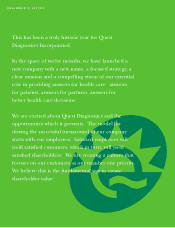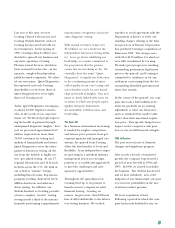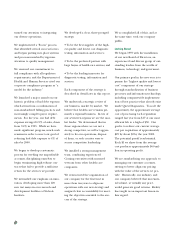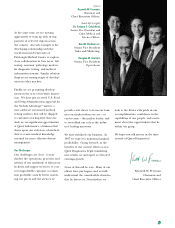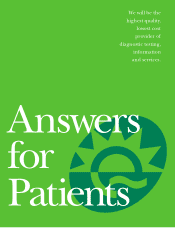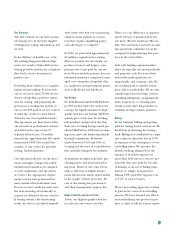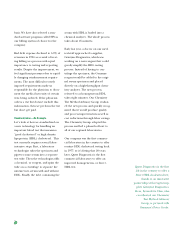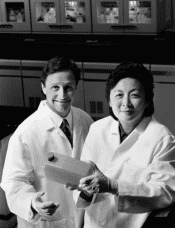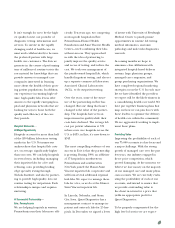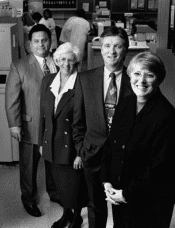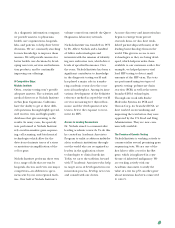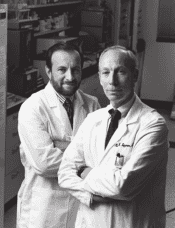Quest Diagnostics 1996 Annual Report Download - page 7
Download and view the complete annual report
Please find page 7 of the 1996 Quest Diagnostics annual report below. You can navigate through the pages in the report by either clicking on the pages listed below, or by using the keyword search tool below to find specific information within the annual report.
6
ately. Some tests that rely on growing
cultures, tissue analysis or esoteric
tests that require amplifying genes
can take longer to complete.
In 1996, we processed approximately
60 million requisitions for testing.
After we provide the test results, we
produce invoices and begin a com-
plex process to get paid for our ser-
vices. Payors include patients, doctors,
indemnity insurance companies, man-
aged care companies, hospitals, clin-
ics, employers and government payors
such as Medicaid and Medicare.
Our History
Dr. Paul Brown founded MetPath Inc.
in 1967 in New York City, with a new
concept for highly automated, high
quality and low cost testing. MetPath
quickly grew to become the leading
independent testing lab in the New
York area. Corning Incorporated pur-
chased MetPath in 1982 and, in ensu-
ing years, grew the business primarily
through acquisitions. Revenues
tripled between 1991 and 1995 as
Corning led the wave of consolidation
that radically reshaped our industry.
Acquisitions brought us growth, pur-
chasing power and national market-
ing clout. However, they also left us
with a collection of highly autono-
mous laboratories which varied widely
in the quality of their processes, the
cost of the testing they performed
and their management approaches.
Highest Quality and Lowest Cost
Today, our highest quality laborato-
ries also are our lowest cost labs.
Our Business
The first element in our three prong-
ed strategy is to be the best supplier
of diagnostic testing, information and
services.
In the delivery of health care, virtu-
ally nothing happens without diag-
nostic test results. Clinical laboratory
testing provides answers for caregivers
that lead to better decisions for
patient care.
Providing these answers is a complex
logistical undertaking. It starts with
one of our more than 75,000 doctor-
clients completing a patient requisi-
tion for testing, and preparing the
specimen or sending the patient to
one of our 850 patient service centers
around the country to have blood
drawn by one of our phlebotomists.
The specimens are then retrieved by
our network of professional couriers
and delivered to one of our 17
regional laboratories, 14 smaller
branch labs, approximately 200 rapid-
turnaround STAT labs around the
country, or our center for specialty
testing, Nichols Institute.
Our labs generally process the speci-
mens overnight. Unique bar-coded
identification numbers are assigned
to each requisition, and specimens
are sent to the appropriate depart-
ments to have tests performed for
most routine blood and urine tests.
Doctors receive results for most tests
the next morning electronically or
reports are delivered by our couriers.
If testing reveals a life-threatening
result, the doctor is notified immedi-
There is a cost difference of approxi-
mately $13 per requisition between
our most efficient and least efficient
labs. Our attention is focused on mak-
ing operations consistent across the
company by implementing best prac-
tices in all our facilities.
Labs with leading regional market
share are typically our most profitable
and generate cash. Yet several labs
with weak market positions are
unprofitable and consume cash. We
are working hard to quickly return
these labs to profitability. We are also
considering several strategic actions
including selling labs, swapping labs
with competitors, or forming joint
ventures with other lab providers to
establish stronger market position.
Billing
In our business, billing and getting
paid for testing has become more dif-
ficult than performing the testing
itself. Billing was established as a sepa-
rate corporate function late in 1995
in response to the emergence of seri-
ous billing issues. We measure the
health of billing ultimately by the
amount of bad debt expense we
incur. Bad debt refers to tests we per-
form but don’t get paid for because
of missing or incorrect billing infor-
mation or, simply, non-payment.
During 1995, bad debt expense rose
to 9.4% of total revenues.
We are now taking aggressive actions
to gain better control of our billing
process. We have focused our efforts
on standardizing our process to pro-
duce a claim or bill on a more timely


